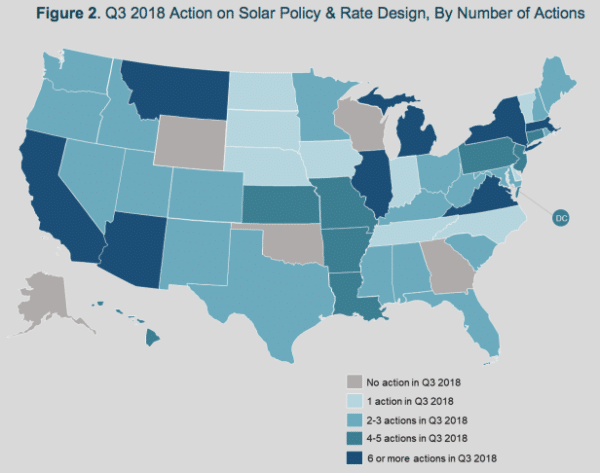More and more states across the nation are undergoing changes in their policies for rooftop solar, which are often driven by utilities using a variety of means to attempt to claw back revenue from their customers who go solar and/or kill the progress of distributed solar.
North Carolina Clean Energy Technology Center’s (NCCETC) Q3 2018 50 States of Solar report, released yesterday, found the greatest number of states involved in policy action over distributed solar in at least a year, with only five U.S. states where nothing substantial happened.

And while the type of action varied, some clear patterns emerged, and one of the biggest trends is utilities attempting to increase fixed charges or minimum bills. As previously documented in EQ Research’s quarterly rate case review as well as previous editions of the NCCETC 50 States study, most of these efforts fall short of what utilities want, but the repeated pushes are slowly ratcheting up fixed charges.
Equally concerning, NCCETC also observes that a second utility was permitted to impose a demand charge on its residential customers during the quarter. Kansas regulators have allowed Westar Energy to impose a demand charge on residential customers who install solar, which follows on Massachusetts regulators approving a similar charge for utility Eversource Energy earlier this year.
Demand charges can be hard to predict and confusing for residential customers, which is why they are usually rejected by regulators. In fact, the decisions in Massachusetts and Kansas are the first two times that pv magazine knows of regulators permitting demand charges on residential customers, although Salt River Project, an unregulated utility cooperative, imposed a demand charge in 2014 which decimated the rooftop solar market in its service area.

But the area of the greatest activity was compensation rules for distributed generation, with 27 states plus Washington D.C. taking some form of action. And here the results for the industry were mixed. While Michigan utilities are filing successor programs to net metering which represent a major step back for solar, Duke Energy has agreed to extend its net metering program in South Carolina through next March, despite hitting the aggregate cap set by state law.
This is set against the bigger picture of more and more utilities deciding how to value solar beyond the simple retail rate compensation that net metering offers. And along with more and more states studying the value of solar, structures are getting more complicated.
“The future of solar compensation is trending toward increasingly complex structures,” said Autumn Proudlove, lead author of the report and Senior Manager of Policy Research at NCCETC. “Some states are identifying the locational value of DERs, while others are piloting time-varying credits or considering demand and grid access charges.”
This content is protected by copyright and may not be reused. If you want to cooperate with us and would like to reuse some of our content, please contact: editors@pv-magazine.com.









Of course they do. People will need to defect in the end if the greedy utilities don’t get seriously regulated. Recently John Berger of Sunniva tore apart Emily Fisher, the rep for the utilities, in a live conference. The utilities do not want to see DG proliferate, for then they will become tertiary. It’s going to happen regardless of what they do. They’ll morph into utilities like in the AUS that want the government to make a utility bill mandatory and defection illegal. Game is on though, and through 2021, the People need to go solar. 2019 is the last full 30% credit year. Acording to Berger, the ITC isn’t even necessary anymore for solar to proliferate. Enphase is the safest, most reliable, and highest longevity solar solution on the planet. Their IQ8 will give people a “battery-less” microinverter solution and offer excellent existing-system upgrade options with real value added. Enphase and SunPower are the enemies of the utilities for sure, but people are sick of getting whacked $300 a month only to be without power for days when a hurricane strikes. The service is poor, and that is going to move people to DG all by itself. Sorry monopolies, we want energy freedom.
Enphase equipment is NOT the answer (unless you are a Enphase Energy salesman… Are you?)
Sure, in a way. Since 2013, I have built 6 strings of solar panels with a combination of M215, M250 and M215 non-IG’s. I have 87 micros now and have not had a utility bill since then. I am an NEM customer. NEM has been reduced in a lot of areas. But, like Sunniva’s John Berger said, even without the ITC, solar+storage is proliferating. DG residential is the way for true reliability not utilities building out huge solar farms. Like John said, you can build the huge solar farms, but you still need to pay to distribute the electricity and get it to each individual end point. The wire and the pole is the Achilles Heal. You said Enphase equipment is NOT the answer. It was for me and my neighbors, and ~1M Enphase customers, so why is it not for you? I’m semi-retired, install solar in the neighborhood I live, have volunteered with GridAlternatives who use Enphase, have taken classes in Paonia, Colorado, where they teach newbies how to use Enphase, and believe solar+storage is the way for true energy freedom for the masses — Nikola Tesla’s dream not JP Morgan’s and Edison’s. Watch this long video if you have the time to see Sunniva’s John Berger and the utility company’s Emily Fisher battle it out. Like John said to Emily — I’d drop NEM and ITC if you deregulate. The Utilities are subsidized — they spend more, they receive more. Sunniva is not — they spend more, they earn less. That is is the underlying difference preventing mass adoption of solar. and furthermore, big utility conglomerates are buying the capacity from the panel makers and trying to suffocate the AC Module production (possibly) with entities like Jinko Jacksonville. Nevertheless, the Long Tail is starting to use ACM’s and have almost doubled in 7 month’s time. No, I don’t work for Enphase, but I am sick of the energy monopolies. It’s high time their stale revenue stream was distributed, literally. Emily talked about centralized power giving reliability. Try selling that in Hurricane Alley — Texas (Harvey), South Carolina (Florence) or more recently Florida (Michael). Luckily, Irma the monster did not wipe us out, and I was without power for a week. I cannot wait to get my hands on IQ8 Ensemble. For a ~$5K upgrade, I’ll be able to convert some of my 20kW system to a 10kW microgrid which will never need fossil fuel to operate — a battery-less microgrid. I’ll get EnCharge 3.3kWh batteries when they are available. I support Enphase 100%. Like the early days when people jumped onto the Apple ship, they became loyalists and sellers of the product because it was a BETTER mousetrap! Here’s a link to that video… https://www.youtube.com/watch?time_continue=2940&v=Ne_JdfrqPGQ
I am the COO for a nationwide solar company that operates in 24 states. In the five years that I’ve been working at greensolartechnologies.com, I’ve seen utilties try everything in order to make solar a less attractive investment. Fees are just one of many different ways including terrible net billing or buy all sell all policies as well as forcing customers to have million dollar liability insurance on their homes! Unreal.
Edward Harner
Deference to author, some fantastic selective information.
Please elaborate.
Thanks for finally writing about >Utilities ssek
greater fees on customers whho go solar – pv magazine USA <Loved it!
May I simply say what a relief to discover somebody who genuinely knows what they’re
talking about on the net. You actually understand how to bring an issue to light and make it important.